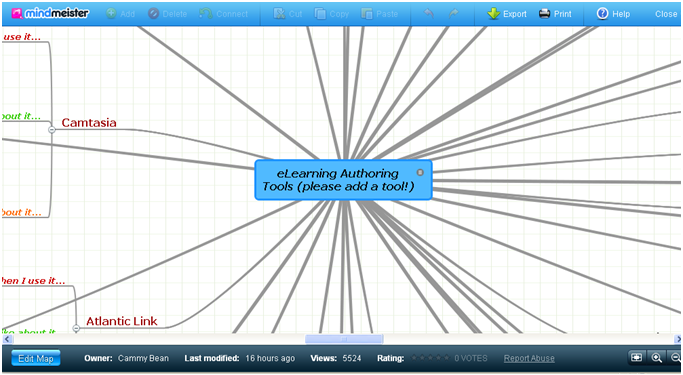I came across this mind map by Cammy Bean which covers nearly all the tools available for creating/authoring eLearning content. She tries to find answers to three simple questions regarding each tools mentioned in the mind map –
– When do I use it?
– What do I like about it?
– What do I not like about it?
For many tools, the answers are as expected. Again, the fact surfaces that not all tools are perfect but each tends to be targeted for specific use cases. The mind map can help learning professionals choose the right authoring tool for their requirements and expectations.
I’ve been wandering around the web to find the right authoring tool for specific use cases. While searching I realized that many learning professionals often confuse between their requirements and the specific features offered by the chosen tool. For example, a feature that lets users “import” existing PowerPoint presentations into the authoring tool is different from authoring and publishing eLearning content from within PowerPoint (using a plug-in toolbar). While some try doing freeform authoring through a template-based authoring tool. However, both methods have different workflows and properties.
Here are some features that eLearning professionals generally expect from authoring tools –
- They should have an intuitive interface – preferably WYSIWYG – allowing easy authoring and simple functionality.
- Should be easy to control and manage graphic styles across course to enforce style guidelines and branding.
- Localization processes using the tool should be easy and fast.
- Should be able to import/export content (like PPT, DOC, or simple HTML), and allow for edits after import.
- Should be able to import external Flash SWF as well as audio and video in variety of popular formats.
- Standard and customizable compliance. (SCORM 1.2, 2004, AICC)
- Should be able to publish course in various formats. (web, LMS, CD-ROM)
- Functionality of some kind for offline tracking if courses are not being delivered from any LMS.
- Ability to capture reviewer notes in context to the pages – one useful feature of collaborative authoring.
One more feature which is not required in most cases but would be much of help to advanced authors – is some way to extend/customize tool functionality through programming. For example, for a course published through Articulate, if I’d wanted SCORM tracking with a different behavior, I might be able to achieve that using the SDK provided by Articulate.
Please note, I haven’t considered full-fledged development tools like Adobe Flash, for which some amount of technical proficiency is required.
What other features/functions you would expect from the eLearning authoring tools you would be or are using?



















